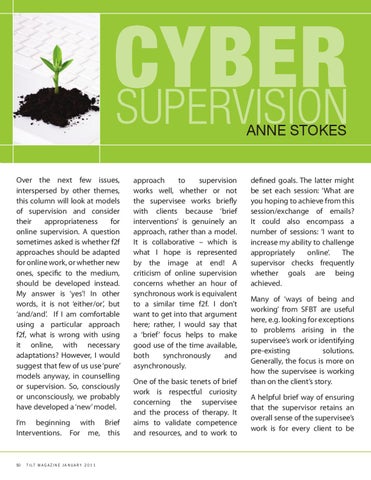TILT – Therapeutic Innovations in Light of Technology
Cyber Supervision Anne Stokes
Over the next few issues, interspersed by other themes, this column will look at models of supervision and consider their appropriateness for online supervision. A question sometimes asked is whether f2f approaches should be adapted for online work, or whether new ones, specific to the medium, should be developed instead. My answer is ‘yes’! In other words, it is not ‘either/or’, but ‘and/and’. If I am comfortable using a particular approach f2f, what is wrong with using it online, with necessary adaptations? However, I would suggest that few of us use ‘pure’ models anyway, in counselling or supervision. So, consciously or unconsciously, we probably have developed a ‘new’ model. I’m beginning with Brief Interventions. For me, this
50
T I L T MAGAZ I N E J a n u a r y 2 0 1 1
approach to supervision works well, whether or not the supervisee works briefly with clients because ‘brief interventions’ is genuinely an approach, rather than a model. It is collaborative – which is what I hope is represented by the image at end! A criticism of online supervision concerns whether an hour of synchronous work is equivalent to a similar time f2f. I don’t want to get into that argument here; rather, I would say that a ‘brief’ focus helps to make good use of the time available, both synchronously and asynchronously. One of the basic tenets of brief work is respectful curiosity concerning the supervisee and the process of therapy. It aims to validate competence and resources, and to work to
defined goals. The latter might be set each session: ‘What are you hoping to achieve from this session/exchange of emails? It could also encompass a number of sessions: ‘I want to increase my ability to challenge appropriately online’. The supervisor checks frequently whether goals are being achieved. Many of ‘ways of being and working’ from SFBT are useful here, e.g. looking for exceptions to problems arising in the supervisee’s work or identifying pre-existing solutions. Generally, the focus is more on how the supervisee is working than on the client’s story. A helpful brief way of ensuring that the supervisor retains an overall sense of the supervisee’s work is for every client to be
